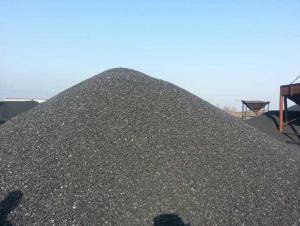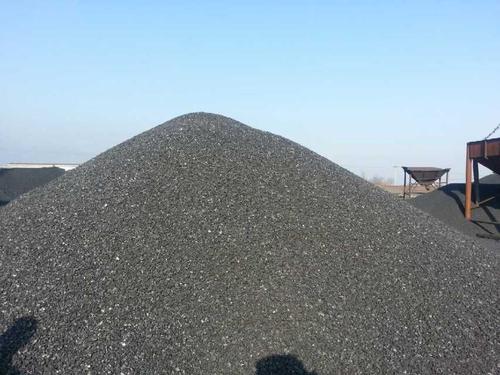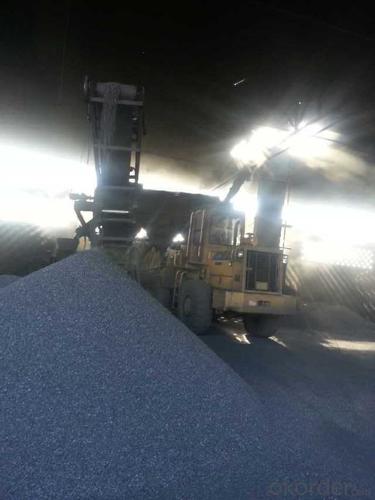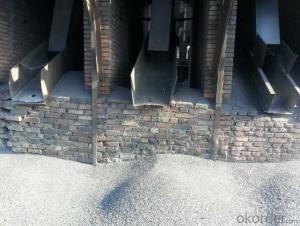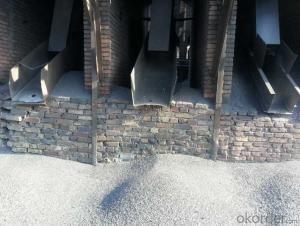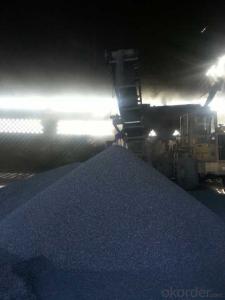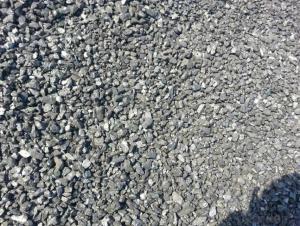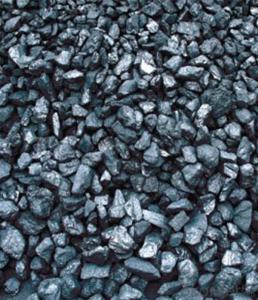Injection Carbon FC94 with Good and Stable Quality
- Loading Port:
- Tianjin
- Payment Terms:
- TT OR LC
- Min Order Qty:
- 20 m.t.
- Supply Capability:
- 5000 m.t./month
OKorder Service Pledge
OKorder Financial Service
You Might Also Like
Injection Carbon FC94 with good and stable quality
Packaging & Delivery
25kgs/50kgs/1ton per bag or as buyer's request
Injection Carbon FC94 with good and stable quality
Specifications
Calcined Anthracite
Fixed carbon: 90%-95%
S: 0.5% max
Size: 0-3. 3-5.3-15 or as request
Injection Carbon FC94 with good and stable quality
It used the high quality anthracite as raw materials through high temperature calcined at over 2000 by the DC electric calciner with results in eliminating the moisture and volatile matter from anthracite efficiently, improving the density and the electric conductivity and strengthening the mechanical strength and anti-oxidation. It has good characteristics with low ash, low resistvity, low sulphur, high carbon and high density. It is the best material for high quality carbon products.
Injection Carbon FC94 with good and stable quality
Advantage and competitive of caclined anthracite:
1. strong supply capability
2. fast transportation
3. lower and reasonable price for your reference
4.low sulphur, low ash
5.fixed carbon:95% -90%
6..sulphur:lower than 0.3%
Injection Carbon FC94 with good and stable quality
General Specification of Calcined Anthracite:
| FC | 95 | 94 | 93 | 92 | 90 |
| ASH | 4 | 5 | 6 | 6.5 | 8.5 |
| V.M. | 1 | 1 | 1 | 1.5 | 1.5 |
| S | 0.3 | 0.3 | 0.3 | 0.35 | 0.35 |
| MOISTURE | 0.5 | 0.5 | 0.5 | 0.5 | 0.5 |
Pictures
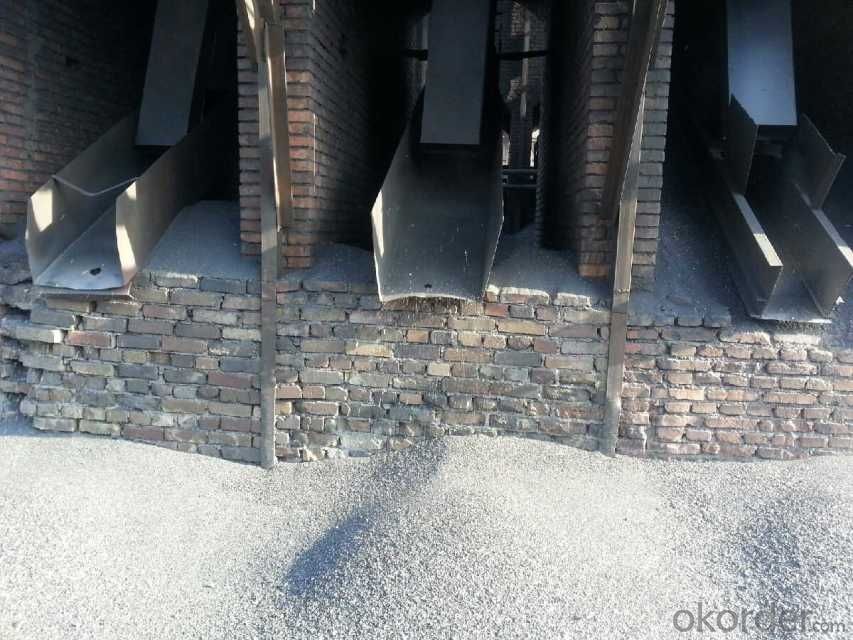
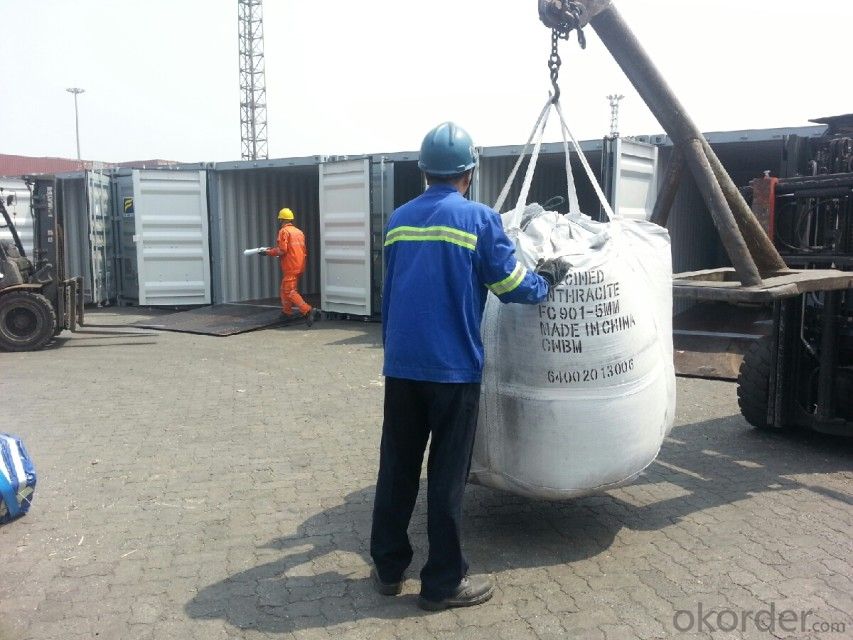
FAQ:
Injection Carbon FC94 with good and stable quality
Why we adopt INJECTION CARBON?
Carbon Additives used as additive in steel making process. It made from well-selected Tai Xi anthracite which is low in content of ash, sulphur, phosphorus, high heat productivity, high chemically activation.
Mainly industry property of it is: instead of traditional pertroleum coal of INJECTION CARBON, reduce the cost of steelmaking.
- Q: What are the impacts of carbon emissions on the stability of rainforests?
- The stability of rainforests is significantly affected by carbon emissions, resulting in negative consequences for both local ecosystems and the global climate. One notable impact is the direct contribution to climate change, as carbon dioxide (CO2) is a major greenhouse gas responsible for trapping heat in the atmosphere. This leads to an enhanced greenhouse effect, causing global temperatures to rise and negatively impact rainforests. As temperatures increase, rainforests face various challenges. Firstly, higher temperatures can result in more frequent and intense droughts, making it difficult for rainforests to maintain moisture levels. This leads to reduced water availability for plants and animals, causing stress, hindered growth, and increased susceptibility to diseases and pests. Additionally, droughts can raise the risk of wildfires, devastating large areas of rainforest and further disrupting the delicate ecosystem. Another significant consequence of carbon emissions is the alteration of rainfall patterns. Climate change disrupts regular rainfall cycles in rainforest regions, leading to either more intense rainfall events or prolonged dry periods. These changes disturb the natural balance within rainforests, affecting the growth and reproduction cycles of plants and animals. For example, certain tree species may struggle to reproduce or regenerate if their seeds require specific conditions that are no longer met due to altered rainfall patterns. Furthermore, carbon emissions contribute to increased concentrations of CO2 in the atmosphere, directly impacting plant physiological processes. While some studies suggest that higher CO2 levels can initially enhance plant growth through increased photosynthesis, the long-term effects are more complex. Elevated CO2 can disrupt the nutrient balance within rainforest ecosystems and may favor certain plant species over others, resulting in shifts in species composition and potentially reducing overall biodiversity. Lastly, the impacts of carbon emissions on rainforests extend beyond the local ecosystem. Rainforests act as crucial carbon sinks, absorbing a significant amount of the world's CO2 emissions. However, as rainforests face increased stress from climate change, their ability to absorb and store carbon may decrease. This creates a dangerous cycle, as reduced carbon storage in rainforests leads to even higher atmospheric CO2 levels, further worsening climate change. In conclusion, carbon emissions have profound effects on the stability of rainforests. From contributing to climate change and altering rainfall patterns to affecting plant physiology and reducing carbon storage capacity, the consequences are extensive and harmful. Protecting rainforests and reducing carbon emissions are crucial steps in preserving the stability and biodiversity of these vital ecosystems.
- Q: What are the different types of carbon fibers?
- There are several different types of carbon fibers, including standard modulus carbon fiber, intermediate modulus carbon fiber, high modulus carbon fiber, and ultra-high modulus carbon fiber. These types vary in their strength, stiffness, and cost, making them suitable for different applications and industries.
- Q: How does carbon impact the availability of sustainable agriculture practices?
- The availability of sustainable agriculture practices is affected by carbon in several ways. Firstly, climate change is contributed to by carbon emissions from human activities, such as burning fossil fuels and deforestation. This change in climate patterns can result in extreme weather events like droughts, floods, and heatwaves, which can have a negative impact on agricultural productivity. Furthermore, the excessive presence of carbon in the atmosphere adds to the greenhouse effect, trapping heat and increasing global temperatures. This rise in temperature can disrupt natural ecosystems and decrease the amount of arable land available for agriculture. It can also change precipitation patterns, causing water scarcity or excessive rainfall, both of which can hinder sustainable agriculture practices. Carbon also plays a role in the health and fertility of soil. Soils can absorb excessive carbon dioxide from the atmosphere, which leads to increased soil acidity. This acidification can lower soil pH levels, making it difficult for crops to absorb necessary nutrients. Additionally, high carbon levels can affect soil microorganisms, which are essential for nutrient cycling and maintaining soil fertility. However, carbon can also have positive effects on sustainable agriculture practices. Carbon sequestration, the process of capturing and storing carbon dioxide from the atmosphere, can be utilized to improve soil health. Practices such as planting cover crops, adopting agroforestry systems, and implementing no-till farming techniques can help sequester carbon in the soil, enhancing its fertility and ability to withstand challenges. This, in turn, promotes sustainable agriculture by increasing crop yields, reducing the need for synthetic fertilizers, and improving the soil's ability to retain water. In conclusion, carbon emissions and their impact on climate change and soil health have a significant influence on the availability of sustainable agriculture practices. It is crucial to mitigate carbon emissions and adopt practices that sequester carbon in order to ensure a sustainable and resilient agricultural system in the face of climate change.
- Q: How does carbon affect air quality?
- Carbon is a major contributor to air pollution as it combines with oxygen to form carbon dioxide (CO2), a greenhouse gas responsible for climate change. Additionally, carbon-based pollutants, such as carbon monoxide (CO) and volatile organic compounds (VOCs), can be released from the combustion of fossil fuels and contribute to poor air quality and negative health effects.
- Q: What is the relationship between carbon emissions and air pollution?
- Carbon emissions and air pollution are closely interconnected. Carbon emissions, which mainly come from burning fossil fuels such as coal, oil, and natural gas, release large amounts of carbon dioxide (CO2) into the atmosphere. This increase in CO2 levels contributes significantly to the greenhouse effect, trapping heat in the atmosphere and leading to global warming. Air pollution, on the other hand, refers to the presence of harmful substances in the air that can be detrimental to human health and the environment. While carbon dioxide itself is not directly toxic to humans, it plays a crucial role in the formation of other air pollutants. One of the primary consequences of increased carbon emissions is the production of fine particulate matter (PM2.5) and ground-level ozone (O3). These pollutants are created through complex chemical reactions involving CO2 and other pollutants like nitrogen oxides (NOx) and volatile organic compounds (VOCs). PM2.5 and O3 are known to cause respiratory problems, cardiovascular diseases, and other health issues. Furthermore, carbon emissions also contribute to the formation of other air pollutants such as sulfur dioxide (SO2), nitrogen oxides (NOx), and heavy metals. These pollutants are emitted alongside CO2 from various industrial processes, power generation, and transportation. They can have severe health impacts, including respiratory diseases, asthma, and even cancer. Reducing carbon emissions is crucial to combatting air pollution. By transitioning to cleaner energy sources like renewables and improving energy efficiency, we can significantly reduce the amount of CO2 and other pollutants emitted into the atmosphere. Implementing stricter regulations and adopting cleaner technologies in industries and transportation can also help reduce air pollution and its associated health risks. In conclusion, carbon emissions and air pollution are intrinsically linked. The release of CO2 and other pollutants from burning fossil fuels contributes to global warming and the formation of harmful air pollutants. Addressing the problem of carbon emissions is essential to mitigate air pollution and protect human health and the environment.
- Q: What is the role of carbon in the human body?
- Carbon plays a crucial role in the human body as it is a fundamental element for all organic molecules. It is the backbone of many biomolecules, including carbohydrates, lipids, proteins, and nucleic acids, which are essential for various physiological processes. Firstly, carbon is a key component of carbohydrates, which are the primary source of energy for the body. Glucose, a simple sugar composed of carbon, hydrogen, and oxygen, is broken down in cells to release energy through cellular respiration. Additionally, carbon forms the structure of complex carbohydrates like glycogen, which is stored in the liver and muscles as an energy reserve. Secondly, carbon is present in lipids, such as fats and oils, which serve as an energy source, insulation, and protection for organs. Carbon atoms are arranged in long hydrocarbon chains, making lipids hydrophobic and allowing them to store and release energy efficiently. Lipids also play a crucial role in cell membrane structure and hormone production. Furthermore, carbon is a fundamental component of proteins, which are involved in almost all cellular processes. Proteins are composed of amino acids, and carbon atoms form the backbone of these amino acids, providing stability and flexibility to the protein structure. Carbon also participates in the formation of peptide bonds, which link amino acids together to build proteins. Proteins are essential for various functions, including enzyme catalysis, transport and storage of molecules, immune response, and cell signaling. Lastly, carbon is a vital element in nucleic acids, such as DNA and RNA, which contain genetic information. Carbon atoms form the sugar-phosphate backbone of nucleic acids, providing stability to the structure. DNA carries hereditary information, while RNA plays a crucial role in protein synthesis. In summary, carbon is essential in the human body as it forms the basis of organic molecules like carbohydrates, lipids, proteins, and nucleic acids. Its versatility and ability to form stable bonds allow for the diverse functions and structures necessary for life processes.
- Q: What are the effects of carbon emissions on the stability of peatlands?
- Carbon emissions have significant effects on the stability of peatlands, leading to various environmental and ecological consequences. Peatlands are wetland ecosystems composed of partially decomposed organic matter, primarily consisting of dead plants and mosses. These ecosystems are known as important carbon sinks, storing large amounts of carbon in the form of plant material and organic peat. When carbon emissions, particularly from the burning of fossil fuels, are released into the atmosphere, it contributes to the overall increase in greenhouse gases, such as carbon dioxide (CO2) and methane (CH4). This increase in greenhouse gases leads to global warming and climate change, which have direct impacts on peatlands. One of the primary effects of carbon emissions on peatlands is the acceleration of peat decomposition. As temperatures rise due to global warming, the rate of microbial activity in peatlands increases, resulting in faster decomposition of organic matter. This process releases carbon dioxide and methane, further contributing to greenhouse gas emissions. The increased decomposition can also lead to the subsidence or sinking of peatlands, which affects their stability and can contribute to land degradation. Additionally, carbon emissions can alter the hydrology of peatlands. Rising temperatures can cause increased evaporation and reduced precipitation, leading to drier conditions in peatlands. This can result in water tables dropping below the surface, which inhibits the growth of mosses and the accumulation of new peat. As a result, peatlands become less capable of sequestering carbon and can even transition into carbon sources rather than sinks. The destabilization of peatlands due to carbon emissions has cascading effects on the overall ecosystem. Peatlands provide habitats for numerous plant and animal species, many of which are unique and highly adapted to these specific environments. The drying and sinking of peatlands can disrupt these ecosystems, leading to changes in the composition and distribution of species, as well as increased susceptibility to invasive species. Furthermore, the release of carbon dioxide and methane from peatlands contributes to the amplification of climate change. These greenhouse gases trap heat in the atmosphere, leading to further warming and exacerbating the cycle of peat decomposition and carbon emissions. In conclusion, carbon emissions have detrimental effects on the stability of peatlands, including accelerated peat decomposition, altered hydrology, and disruption of ecosystems. These impacts not only hinder peatlands' ability to sequester carbon but also contribute to climate change, creating a negative feedback loop. It is crucial to reduce carbon emissions and prioritize the preservation and restoration of peatlands to mitigate these effects and protect these valuable ecosystems.
- Q: I saw a cell phone in the magazine, the global release of 900, no camera, what function is F1 carbon fiber material, actually sold 40000 yuan a piece!.. Everyone said that the circulation is so small, worth so much money? Or carbon fiber material worth so much money?
- Carbon fiber material is very expensive, we are specializing in the production of carbon fiber bicycle accessories company, we know more about this industry.. Such an analogy, an aluminum alloy wheel, that is, the cost of more than 100 yuan, to replace the same carbon fiber material costs more than 1000 of the cost.. Carbon fiber belongs to high-end materials, and foreign countries is to control production, because many weapons and aircraft also use this material, the United States will build weapons in other countries, so are the strict control of each production state of carbon fiber materials..
- Q: How does carbon impact the migration patterns of animals?
- The migration patterns of animals are significantly influenced by carbon emissions and climate change. The increased release of carbon dioxide into the atmosphere causes global warming, which in turn changes the timing and availability of vital resources necessary for migration, such as food and water. One visible effect of carbon emissions on animal migration is the modification of seasonal patterns. As the climate warms, the timing of seasons shifts, impacting the accessibility of food sources that animals depend on during migration. For example, an earlier arrival of spring can lead to a mismatch between the timing of migration and the availability of food, resulting in negative consequences for the survival and reproduction of migratory species. Moreover, climate change, caused by carbon emissions, has an impact on the habitats and ecosystems that animals rely on during migration. Increasing temperatures and changing precipitation patterns can result in the loss or deterioration of crucial habitats, such as wetlands or coastal areas, which serve as stopping points or breeding grounds for migratory animals. This loss of habitat disrupts migration routes and causes changes in the distribution and abundance of species. Additionally, carbon emissions contribute to the acidification of oceans, which has severe consequences for migratory species that depend on marine ecosystems. Acidification affects the availability of food and hampers the reproductive success of marine species, leading to changes in migration patterns and population dynamics. In summary, the impact of carbon emissions on animal migration patterns is intricate and diverse. It disrupts the delicate balance of ecosystems by altering the availability of resources and habitats that animals rely on during migration. Understanding these impacts is crucial for developing effective conservation strategies to mitigate the negative consequences of climate change on migratory species and preserve the integrity of their habitats.
- Q: How does carbon impact the quality of freshwater systems?
- Carbon can impact the quality of freshwater systems in various ways. Carbon dioxide (CO2) dissolved in water can lower its pH, leading to increased acidity and potentially harming aquatic organisms. Additionally, excessive carbon inputs from human activities like the burning of fossil fuels can contribute to eutrophication, causing algal blooms and depleting oxygen levels in water bodies, further compromising the health of freshwater ecosystems.
Send your message to us
Injection Carbon FC94 with Good and Stable Quality
- Loading Port:
- Tianjin
- Payment Terms:
- TT OR LC
- Min Order Qty:
- 20 m.t.
- Supply Capability:
- 5000 m.t./month
OKorder Service Pledge
OKorder Financial Service
Similar products
Hot products
Hot Searches
